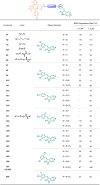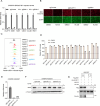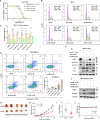Alkenyl oxindole is a novel PROTAC moiety that recruits the CRL4DCAF11 E3 ubiquitin ligase complex for targeted protein degradation
- PMID: 38768083
- PMCID: PMC11104598
- DOI: 10.1371/journal.pbio.3002550
Alkenyl oxindole is a novel PROTAC moiety that recruits the CRL4DCAF11 E3 ubiquitin ligase complex for targeted protein degradation
Abstract
Alkenyl oxindoles have been characterized as autophagosome-tethering compounds (ATTECs), which can target mutant huntingtin protein (mHTT) for lysosomal degradation. In order to expand the application of alkenyl oxindoles for targeted protein degradation, we designed and synthesized a series of heterobifunctional compounds by conjugating different alkenyl oxindoles with bromodomain-containing protein 4 (BRD4) inhibitor JQ1. Through structure-activity relationship study, we successfully developed JQ1-alkenyl oxindole conjugates that potently degrade BRD4. Unexpectedly, we found that these molecules degrade BRD4 through the ubiquitin-proteasome system, rather than the autophagy-lysosomal pathway. Using pooled CRISPR interference (CRISPRi) screening, we revealed that JQ1-alkenyl oxindole conjugates recruit the E3 ubiquitin ligase complex CRL4DCAF11 for substrate degradation. Furthermore, we validated the most potent heterobifunctional molecule HL435 as a promising drug-like lead compound to exert antitumor activity both in vitro and in a mouse xenograft tumor model. Our research provides new employable proteolysis targeting chimera (PROTAC) moieties for targeted protein degradation, providing new possibilities for drug discovery.
Copyright: © 2024 Wang et al. This is an open access article distributed under the terms of the Creative Commons Attribution License, which permits unrestricted use, distribution, and reproduction in any medium, provided the original author and source are credited.
Conflict of interest statement
The authors have declared that no competing interests exist.
Figures





Similar articles
-
Design, Synthesis, and Activity Evaluation of BRD4 PROTAC Based on Alkenyl Oxindole-DCAF11 Pair.J Med Chem. 2024 Nov 14;67(21):19428-19447. doi: 10.1021/acs.jmedchem.4c01767. Epub 2024 Oct 30. J Med Chem. 2024. PMID: 39475482
-
Photo-Activated PROTACs for Targeted BRD4 Degradation and Synergistic Photodynamic Therapy in Bladder Cancer.Mol Pharm. 2025 Jun 2;22(6):3388-3400. doi: 10.1021/acs.molpharmaceut.5c00271. Epub 2025 May 17. Mol Pharm. 2025. PMID: 40380932
-
Harnessing the SPOP E3 Ubiquitin Ligase via a Bridged Proteolysis Targeting Chimera (PROTAC) Strategy for Targeted Protein Degradation.J Med Chem. 2025 Apr 24;68(8):8634-8647. doi: 10.1021/acs.jmedchem.5c00295. Epub 2025 Apr 9. J Med Chem. 2025. PMID: 40202531
-
Synthesis, SAR, and application of JQ1 analogs as PROTACs for cancer therapy.Bioorg Med Chem. 2024 Oct 1;112:117875. doi: 10.1016/j.bmc.2024.117875. Epub 2024 Aug 16. Bioorg Med Chem. 2024. PMID: 39178586 Review.
-
Recent Advances in PROTACs for Drug Targeted Protein Research.Int J Mol Sci. 2022 Sep 7;23(18):10328. doi: 10.3390/ijms231810328. Int J Mol Sci. 2022. PMID: 36142231 Free PMC article. Review.
Cited by
-
Implications of frequent hitter E3 ligases in targeted protein degradation screens.Nat Chem Biol. 2025 Apr;21(4):474-481. doi: 10.1038/s41589-024-01821-z. Epub 2025 Jan 27. Nat Chem Biol. 2025. PMID: 39870762 Review.
-
R406 and its structural analogs reduce SNCA/α-synuclein levels via autophagic degradation.Autophagy. 2025 Sep;21(9):1945-1961. doi: 10.1080/15548627.2025.2483886. Epub 2025 Apr 4. Autophagy. 2025. PMID: 40143425 Free PMC article.
-
Exploring Arylidene-Indolinone Ligands of Autophagy Proteins LC3B and GABARAP.ACS Med Chem Lett. 2025 Jan 6;16(2):271-277. doi: 10.1021/acsmedchemlett.4c00517. eCollection 2025 Feb 13. ACS Med Chem Lett. 2025. PMID: 39967642
-
Exploring Arylidene-Indolinone Ligands of Autophagy Proteins LC3B and GABARAP.bioRxiv [Preprint]. 2024 Oct 29:2024.02.25.581879. doi: 10.1101/2024.02.25.581879. bioRxiv. 2024. Update in: ACS Med Chem Lett. 2025 Jan 06;16(2):271-277. doi: 10.1021/acsmedchemlett.4c00517. PMID: 39554136 Free PMC article. Updated. Preprint.
-
Recommended Tool Compounds: Thienotriazolodiazepines-Derivatized Chemical Probes to Target BET Bromodomains.ACS Pharmacol Transl Sci. 2025 Mar 14;8(4):978-1012. doi: 10.1021/acsptsci.4c00726. eCollection 2025 Apr 11. ACS Pharmacol Transl Sci. 2025. PMID: 40242580 Review.
References
-
- Ciechanover A. Intracellular Protein Degradation: From a Vague Idea, through the Lysosome and the Ubiquitin–Proteasome System, and onto Human Diseases and Drug Targeting. Angew Chem Int Ed. 2005;44(37):5944–5967. - PubMed
MeSH terms
Substances
LinkOut - more resources
Full Text Sources
Other Literature Sources

